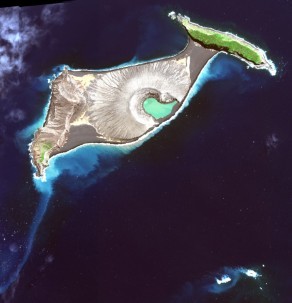From Top to Bottom: Scientists Map a New Island Volcano
One of the earth’s newest islands exploded into view from the bottom of the southwest Pacific Ocean in January 2015, and scientists sailing around the volcano this spring have created a detailed map of its topography.

One of the earth’s newest islands exploded into view from the bottom of the southwest Pacific Ocean in January 2015, and scientists sailing around the volcano this spring have created a detailed map of its topography. You can see an animation of the volcano, mostly underwater, by clicking on the above image.

The Schmidt Ocean Institute’s research vessel Falkor conducted the mapping in collaboration with NASA during a research cruise whose focus was actually elsewhere: exploring marine life around the hydrothermal vent fields of the nearby eastern Lau Basin, near the island Kingdom of Tonga. Lamont-Doherty Earth Observatory scientist Vicki Ferrini, who uses geophysical mapping techniques to study the seafloor, was aboard the R/V Falkor and helped process the mapping data.
Because much of the landscape dynamics associated with new oceanic island volcanoes happens underwater, this unique project of opportunity provides scientists at NASA and Lamont-Doherty with an integrated view of the three dimensional character of the new island, from the seafloor to its approximately 130-meter-tall summit above sea-level, all at meter-scale resolution.

The new island—unofficially named Hunga Tonga Hunga Ha’apai—was formed in what’s called a “surtseyan” eruption, named after the island of Surtsey off the southern coast of Iceland. In such events, hot magma rising from the seafloor into cool water causes a violent blast of ash and rock. (The name “Surtsey” derives from Surtr, a fire giant from Norse mythology.)
The mapping will help researchers understand how such rapidly formed volcanic islands evolve and why their survival as land is often limited. Preliminary analysis by Ferrini and NASA scientists from the Goddard Space Flight Center show why the new island has lost nearly 30 percent of its initial land area in only 15 months since the eruptive activity ended in late January 2015. The work showed that the submarine topography around the new island clearly affects the pace and location of erosion due primarily to marine abrasion and local subsidence.
The work will contribute to understanding of hydro-volcanic processes on planets such as Mars, where similar-appearing volcanic structures have been observed by NASA satellites such as the Mars Reconnaissance Orbiter.
The mapping also contributes to a project to extend satellite-based measurements that NASA’s Earth Sciences Program began in summer of 2015 with collaborators from the National Geospatial-Intelligence Agency and the Canadian Space Agency, as well as the German Space Agency.
For a full news release on the mapping, visit the Schmidt Ocean Institute site.
For more on Ferrini’s work, read a previous post on State of the Planet.

